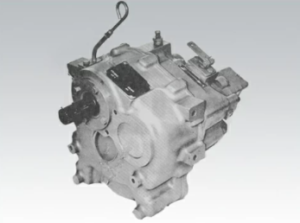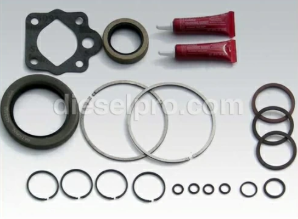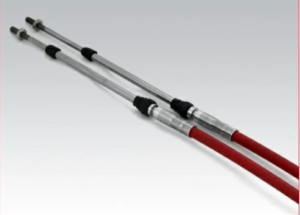
The Twin Disc MG502 Marine Gear is engineered for durability and reliable performance in marine applications. However, like any complex mechanical system, it can encounter issues that require troubleshooting. Whether the problem is difficulty engaging gear, excessive noise or vibration, fluid leaks, overheating, or control system malfunctions, systematic troubleshooting is essential for diagnosing and resolving these issues efficiently.
This comprehensive 5000-word guide explores the most common problems associated with the Twin Disc MG502, providing detailed solutions and preventive measures to ensure the gearbox continues to operate at peak performance.
Difficulty Engaging Gear in Twin Disc MG502 Marine Gear
Difficulty in engaging the gear can severely affect vessel performance and safety. This issue may stem from hydraulic system malfunctions, mechanical misalignments, or worn components.
Parts Catalog for Twin Disc MG502 Marine Transmissions
Rebuilt Twin Disc MG502 Marine Transmissions
Bearings For Twin Disc MG502 Marine Transmissions
Plate Kit For Twin Disc MG502 Marine Transmission
Gasket Kits For Twin Disc MG502 Marine Transmission
1. Common Causes of Gear Engagement Issues
- Hydraulic Pressure Loss: Insufficient hydraulic pressure can prevent the clutch from engaging properly.
- Worn Clutch Plates: Damaged or worn clutch plates can result in incomplete engagement.
- Contaminated Hydraulic Fluid: Debris or degraded hydraulic fluid can interfere with clutch operations.
- Misaligned Control Linkages: If control linkages are misaligned, they can restrict clutch movement.
- Valve Blockages: Hydraulic control valves may be clogged, restricting fluid flow.
2. Troubleshooting Steps for Gear Engagement Problems
-
Step 1: Inspect Hydraulic Fluid Levels and Quality
- Check Fluid Level: Ensure hydraulic fluid is at the correct level.
- Inspect Fluid Condition: Look for signs of contamination, such as discoloration, sludge, or metal particles.
- Flush and Replace Fluid: If contamination is detected, flush the system and replace with clean, approved hydraulic fluid.
-
Step 2: Test Hydraulic Pressure
- Use a Pressure Gauge: Attach a pressure gauge to the hydraulic system to verify pressure levels.
- Compare to Specifications: The pressure should meet the manufacturer’s recommended levels.
- Address Low Pressure: If pressure is low, inspect the pump and hydraulic lines for leaks or blockages.
-
Step 3: Inspect Clutch Components
- Disassemble Clutch Housing: Inspect clutch plates for warping, scoring, or excessive wear.
- Measure Plate Thickness: Replace plates that fall below minimum thickness specifications.
- Inspect Springs and Bearings: Replace any worn or damaged components.
-
Step 4: Verify Control Linkages
- Check for Misalignment: Ensure that control linkages are properly aligned and free from obstructions.
- Lubricate Moving Parts: Apply lubrication to moving parts to ensure smooth operation.
3. Preventive Measures for Gear Engagement Issues
- Regular Fluid Changes: Change hydraulic fluid at intervals recommended by the manufacturer.
- Routine Inspection of Clutch System: Inspect clutch plates and springs during scheduled maintenance.
- System Pressure Testing: Regularly test hydraulic pressure to detect early signs of issues.
Excessive Noise or Vibration in Twin Disc MG502 Marine Gear
Unusual noise or vibration can indicate underlying mechanical issues that, if ignored, may lead to severe damage or operational failure.
1. Common Causes of Noise and Vibration
- Misaligned Shafts: Misalignment between the engine and gearbox can lead to vibrations.
- Worn Bearings: Bearings that are worn or improperly lubricated can cause noise and vibration.
- Gear Wear: Damaged gear teeth can produce grinding or whining noises.
- Loose Fasteners: Vibrations can loosen bolts, resulting in rattling noises.
- Imbalance in Rotating Components: Shaft imbalance can cause significant vibration.
2. Troubleshooting Steps for Noise and Vibration
-
Step 1: Visual Inspection
- Check for Loose Fasteners: Tighten any loose bolts or nuts.
- Inspect Gear Teeth: Look for worn or chipped teeth on gears.
- Check for Shaft Misalignment: Use alignment tools to verify shaft alignment.
-
Step 2: Conduct Vibration Analysis
- Use Vibration Sensors: Attach sensors to key areas of the gearbox.
- Record and Analyze Data: Compare vibration data to manufacturer standards.
- Correct Imbalances: Adjust or replace imbalanced components.
-
Step 3: Lubrication Check
- Inspect Bearings: Remove and inspect bearings for wear and damage.
- Grease Bearings: Apply fresh grease and ensure it’s distributed evenly.
-
Step 4: Run Noise Isolation Tests
- Identify Noise Sources: Isolate the gearbox from the engine to determine the exact source of the noise.
- Listen for Irregular Noises: Grinding, knocking, or whining can indicate specific component failures.
3. Preventive Measures for Noise and Vibration
- Regular Alignment Checks: Ensure shafts are aligned during every maintenance cycle.
- Routine Bearing Inspection: Replace bearings showing early signs of wear.
- Fastener Re-Torqueing: Regularly check and tighten fasteners to manufacturer specifications.
Fluid Leaks and Seal Failures in Twin Disc MG502 Marine Gear

Fluid leaks compromise the lubrication and hydraulic functions of the gearbox, potentially causing overheating, wear, and failure.
1. Common Causes of Fluid Leaks
- Worn Seals: Seals degrade over time and can crack or lose flexibility.
- Gasket Failures: Gaskets can compress, crack, or disintegrate, leading to leaks.
- Improper Fastening: Loose bolts can allow fluid to seep through gasketed joints.
- Corroded Components: Corrosion around seals can lead to gaps and leaks.
2. Troubleshooting Steps for Fluid Leaks
-
Step 1: Identify Leak Source
- Visual Inspection: Trace fluid trails to the source.
- Inspect Seals and Gaskets: Look for cracks, wear, or damage.
- Pressure Test: Conduct pressure tests to detect hidden leaks.
-
Step 2: Replace Worn Components
- Remove and Replace Seals: Install new seals, ensuring proper lubrication during installation.
- Replace Gaskets: Use manufacturer-approved gaskets and apply sealant if necessary.
-
Step 3: Tighten Fasteners
- Check Torque Levels: Ensure all bolts are tightened to specifications.
- Monitor for Recurrence: After repairs, run the gearbox to confirm the leak has been resolved.
3. Preventive Measures for Fluid Leaks
- Seal and Gasket Inspections: Inspect and replace these components regularly.
- Maintain Correct Fluid Levels: Overfilling can lead to seal blowouts.
- Surface Cleanliness: Ensure mating surfaces are clean before gasket installation.
Overheating Concerns in Twin Disc MG502 Marine Gear
Overheating can cause significant damage to the gearbox, including warping components, breaking seals, and degrading fluids.
1. Common Causes of Overheating
- Low Lubricant Levels: Inadequate lubrication increases friction and heat.
- Blocked Cooling Systems: Clogged oil coolers reduce heat dissipation.
- Contaminated Fluids: Dirty oil loses its cooling properties.
- Overloaded Gear System: Excessive load can increase operational temperatures.
2. Troubleshooting Steps for Overheating
-
Step 1: Fluid Inspection
- Check Fluid Levels: Refill low reservoirs.
- Inspect Fluid Quality: Replace any contaminated fluids.
-
Step 2: Cooling System Check
- Inspect Oil Coolers: Ensure they are free from blockages.
- Flush the System: If contaminants are found, flush the entire cooling system.
-
Step 3: Operational Load Assessment
- Analyze Load Capacity: Ensure the gearbox is not operating beyond its load limits.
- Reduce Load: If overheating persists, reduce operational demands temporarily.
3. Preventive Measures for Overheating
- Routine Fluid Changes: Maintain optimal fluid conditions.
- Cooling System Maintenance: Clean and inspect oil coolers regularly.
- Load Monitoring: Avoid overloading the system during operations.
Control System Malfunctions in Twin Disc MG502 Marine Gear

Control system issues can disrupt gear shifting and hydraulic pressure regulation, affecting operational efficiency.
1. Common Causes of Control Malfunctions
- Worn Control Cables: Frayed or stiff cables can restrict movement.
- Hydraulic Pressure Issues: Fluctuations can hinder proper control.
- Sensor Failures: Malfunctioning sensors can give inaccurate readings.
- Valve Blockages: Clogged control valves can obstruct fluid movement.
2. Troubleshooting Steps for Control System Malfunctions
-
Step 1: Inspect Control Cables
- Check for Fraying: Replace any damaged cables.
- Lubricate Cables: Ensure smooth movement.
-
Step 2: Hydraulic Pressure Check
- Measure Pressure: Use gauges to check hydraulic levels.
- Flush System: Remove any blockages in control valves.
-
Step 3: Electronic Diagnostic
- Test Sensors: Use diagnostic tools to verify sensor accuracy.
- Replace Faulty Sensors: Install new components if required.
3. Preventive Measures for Control System Malfunctions
- Routine Cable Inspection: Check and lubricate control cables regularly.
- Hydraulic System Testing: Regularly test hydraulic pressure and inspect for any leaks or blockages in control valves and lines.
- Sensor Maintenance: Periodically test sensors for accuracy and replace them if they display inconsistent readings.
- Electrical System Checks: Ensure all electrical connections are secure, and wiring is free from corrosion or wear.
- Control Valve Cleaning: Clean control valves during scheduled maintenance to prevent blockages that could disrupt fluid flow.
Conclusion
The Twin Disc MG502 Marine Gear is a high-performance and robust marine transmission system. However, like any mechanical component operating under demanding marine conditions, it is susceptible to wear and potential failures. Proactive and systematic troubleshooting is essential for maintaining optimal performance, minimizing downtime, and extending the operational life of the system.
This comprehensive guide covered the most common troubleshooting scenarios and provided detailed steps for diagnosing and resolving issues related to:
- Difficulty Engaging Gear: Addressing problems caused by hydraulic pressure loss, worn clutch components, or misaligned control linkages.
- Excessive Noise or Vibration: Identifying and resolving problems due to misaligned shafts, worn bearings, and gear wear.
- Fluid Leaks and Seal Failures: Diagnosing leaks caused by worn seals or improperly torqued fasteners and providing steps for resolution.
- Overheating Concerns: Offering solutions to prevent overheating from low lubrication, blocked cooling systems, and overloading.
- Control System Malfunctions: Troubleshooting issues with control cables, hydraulic pressure, sensors, and valves to ensure smooth operations.
Key Takeaways for Preventive Maintenance
- Regular Inspections: Conduct systematic inspections of critical components, including seals, bearings, gears, and hydraulic systems.
- Scheduled Fluid Changes: Regularly replace hydraulic and lubrication fluids to prevent contamination and maintain efficient operation.
- Alignment Checks: Verify shaft and gear alignment during every major service interval to avoid wear and inefficiency.
- Monitor Operational Data: Continuously monitor noise, vibration, and temperature to detect early signs of potential failures.
- Timely Repairs: Address minor issues promptly to prevent escalation into more severe and costly problems.
By following these detailed troubleshooting steps and preventive maintenance practices, marine technicians and operators can ensure that the Twin Disc MG502 Marine Gear operates efficiently and reliably, even in the most demanding marine environments.
Disclaimer: While this guide provides comprehensive troubleshooting steps, for complex issues or concerns outside routine maintenance, always consult with a qualified marine technician or refer to the official Twin Disc MG502 Service Manual for detailed specifications and manufacturer guidelines.

Rebuilt Twin Disc MG502 Marine Transmissions
Bearings For Twin Disc MG502 Marine Transmissions
Plate Kit For Twin Disc MG502 Marine Transmission
Gasket Kits For Twin Disc MG502 Marine Transmission
Videos About Twin Disc Transmissions
6 Reasons Your Twin Disc Transmission Has Low Oil Pressure
7 Reasons Your Twin Disc Transmission Is Overheating
3 Reasons Your Clutch Plates in Your Twin Disc Transmission Are Making Excessive Noise
Bull Gear On A Twin Disc Transmission
Rebuilt Twin Disc Transmissions



 Free US Calls: 1-888-433-4735
Free US Calls: 1-888-433-4735 International: 305-545-5588
International: 305-545-5588